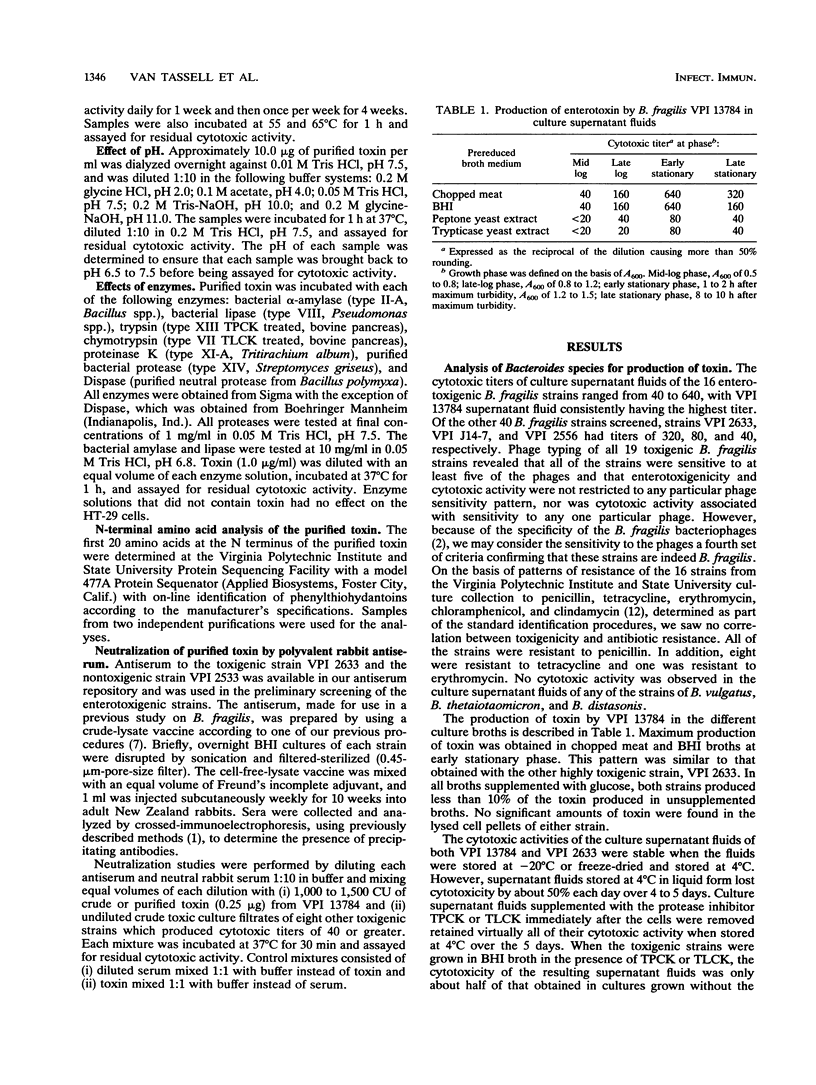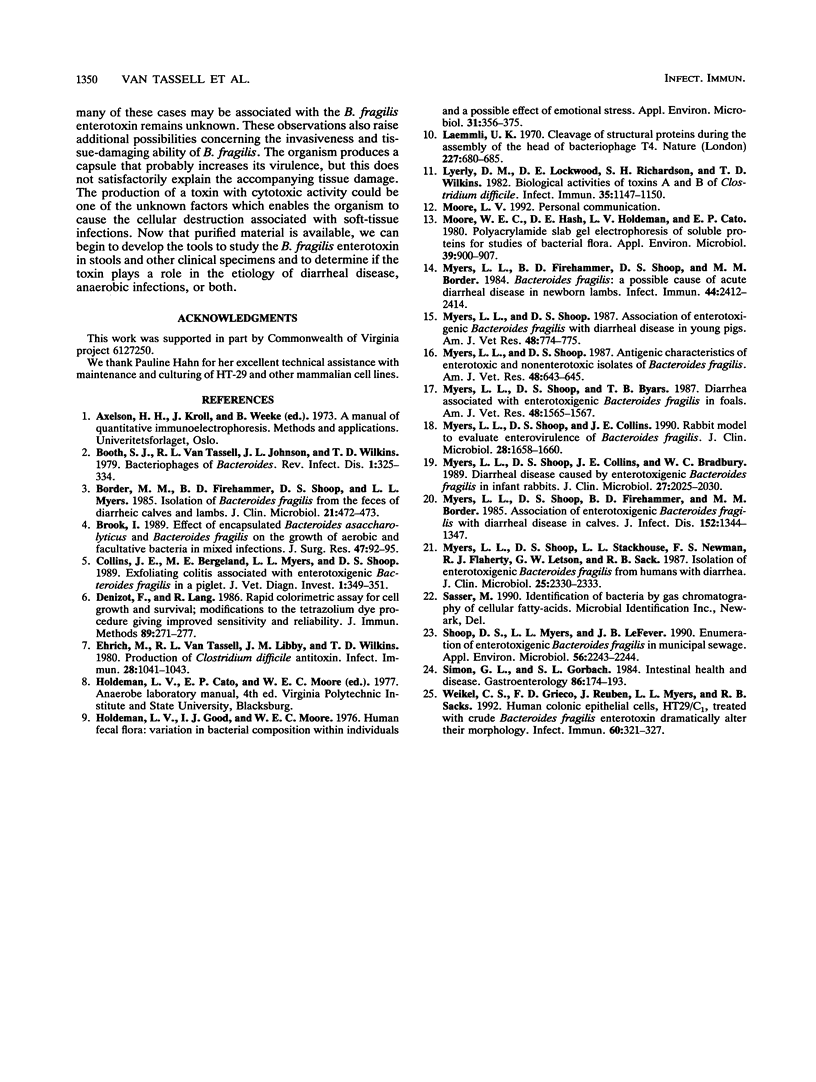Abstract
An enterotoxin produced by Bacteroides fragilis was purified to homogeneity and characterized as to its biological activity and basic molecular properties. Toxin preparations were prepared by growing B. fragilis VPI 13784 in brain heart infusion broth to early stationary phase, immediately precipitating the culture supernatant fluid with 70% ammonium sulfate, and stabilizing the precipitate with the protease inhibitor TPCK (tolylsulfonyl phenylalanyl chloromethyl ketone). The toxin was sequentially purified by anion-exchange chromatography on Q-Sepharose, hydrophobic interaction chromatography on phenyl-agarose, and high-resolution ion-exchange chromatography on Mono Q. The toxin appeared homogeneous as judged by polyacrylamide gel electrophoresis. The estimated molecular weight of the highly purified toxin as determined by gel filtration chromatography on Superose-12 and sodium dodecyl sulfate-polyacrylamide gel electrophoresis is 19,000. It has an isoelectric point of approximately 4.5 and is stable at pHs 5 to 10. The purified toxin is stable at -20 and 4 degrees C and upon freeze-drying, but it is unstable at temperatures above 55 degrees C. It is sensitive to proteinase K and Streptomyces protease but is resistant to trypsin and chymotrypsin. The activity of the purified toxin is neutralized by antiserum to a toxigenic strain of B. fragilis but not by antiserum to nontoxigenic strains. N-terminal amino acid analysis reveal an unambiguous sequence of Ala-Val-Pro-Ser-Glu-Pro-Lys-Thr-Val-Tyr-Val-Ile-Xxx-Leu-Arg-Glu-Asn-Gly- Ser-Thr . The highly purified toxin induced a strong fluid accumulation response in the lamb ileal-loop assay as well as a cytotoxic response (cell rounding) on HT-29 colon carcinoma cells. Thus, the purified toxin can cause both enterotoxic and cytotoxic activities.
Full text
PDF







Images in this article
Selected References
These references are in PubMed. This may not be the complete list of references from this article.
- Booth S. J., Van Tassell R. L., Johnson J. L., Wilkins T. D. Bacteriophages of Bacteroides. Rev Infect Dis. 1979 Mar-Apr;1(2):325–336. doi: 10.1093/clinids/1.2.325. [DOI] [PubMed] [Google Scholar]
- Border M., Firehammer B. D., Shoop D. S., Myers L. L. Isolation of Bacteroides fragilis from the feces of diarrheic calves and lambs. J Clin Microbiol. 1985 Mar;21(3):472–473. doi: 10.1128/jcm.21.3.472-473.1985. [DOI] [PMC free article] [PubMed] [Google Scholar]
- Brook I. Effect of encapsulated Bacteroides asaccharolyticus and Bacteroides fragilis on the growth of aerobic and facultative bacteria in mixed infections. J Surg Res. 1989 Jul;47(1):92–95. doi: 10.1016/0022-4804(89)90053-x. [DOI] [PubMed] [Google Scholar]
- Collins J. E., Bergeland M. E., Myers L. L., Shoop D. S. Exfoliating colitis associated with enterotoxigenic Bacteroides fragilis in a piglet. J Vet Diagn Invest. 1989 Oct;1(4):349–351. doi: 10.1177/104063878900100413. [DOI] [PubMed] [Google Scholar]
- Denizot F., Lang R. Rapid colorimetric assay for cell growth and survival. Modifications to the tetrazolium dye procedure giving improved sensitivity and reliability. J Immunol Methods. 1986 May 22;89(2):271–277. doi: 10.1016/0022-1759(86)90368-6. [DOI] [PubMed] [Google Scholar]
- Ehrich M., Van Tassell R. L., Libby J. M., Wilkins T. D. Production of Clostridium difficile antitoxin. Infect Immun. 1980 Jun;28(3):1041–1043. doi: 10.1128/iai.28.3.1041-1043.1980. [DOI] [PMC free article] [PubMed] [Google Scholar]
- Holdeman L. V., Good I. J., Moore W. E. Human fecal flora: variation in bacterial composition within individuals and a possible effect of emotional stress. Appl Environ Microbiol. 1976 Mar;31(3):359–375. doi: 10.1128/aem.31.3.359-375.1976. [DOI] [PMC free article] [PubMed] [Google Scholar]
- Laemmli U. K. Cleavage of structural proteins during the assembly of the head of bacteriophage T4. Nature. 1970 Aug 15;227(5259):680–685. doi: 10.1038/227680a0. [DOI] [PubMed] [Google Scholar]
- Lyerly D. M., Lockwood D. E., Richardson S. H., Wilkins T. D. Biological activities of toxins A and B of Clostridium difficile. Infect Immun. 1982 Mar;35(3):1147–1150. doi: 10.1128/iai.35.3.1147-1150.1982. [DOI] [PMC free article] [PubMed] [Google Scholar]
- Moore W. E., Hash D. E., Holdeman L. V., Cato E. P. Polyacrylamide slab gel electrophoresis of soluble proteins for studies of bacterial floras. Appl Environ Microbiol. 1980 Apr;39(4):900–907. doi: 10.1128/aem.39.4.900-907.1980. [DOI] [PMC free article] [PubMed] [Google Scholar]
- Myers L. L., Shoop D. S. Antigenic characteristics of enterotoxigenic and nonenterotoxigenic isolates of Bacteroides fragilis. Am J Vet Res. 1987 Apr;48(4):643–645. [PubMed] [Google Scholar]
- Myers L. L., Shoop D. S. Association of enterotoxigenic Bacteroides fragilis with diarrheal disease in young pigs. Am J Vet Res. 1987 May;48(5):774–775. [PubMed] [Google Scholar]
- Myers L. L., Shoop D. S., Byars T. D. Diarrhea associated with enterotoxigenic Bacteroides fragilis in foals. Am J Vet Res. 1987 Nov;48(11):1565–1567. [PubMed] [Google Scholar]
- Myers L. L., Shoop D. S., Collins J. E., Bradbury W. C. Diarrheal disease caused by enterotoxigenic Bacteroides fragilis in infant rabbits. J Clin Microbiol. 1989 Sep;27(9):2025–2030. doi: 10.1128/jcm.27.9.2025-2030.1989. [DOI] [PMC free article] [PubMed] [Google Scholar]
- Myers L. L., Shoop D. S., Collins J. E. Rabbit model to evaluate enterovirulence of Bacteroides fragilis. J Clin Microbiol. 1990 Jul;28(7):1658–1660. doi: 10.1128/jcm.28.7.1658-1660.1990. [DOI] [PMC free article] [PubMed] [Google Scholar]
- Myers L. L., Shoop D. S., Firehammer B. D., Border M. M. Association of enterotoxigenic Bacteroides fragilis with diarrheal disease in calves. J Infect Dis. 1985 Dec;152(6):1344–1347. doi: 10.1093/infdis/152.6.1344. [DOI] [PMC free article] [PubMed] [Google Scholar]
- Myers L. L., Shoop D. S., Stackhouse L. L., Newman F. S., Flaherty R. J., Letson G. W., Sack R. B. Isolation of enterotoxigenic Bacteroides fragilis from humans with diarrhea. J Clin Microbiol. 1987 Dec;25(12):2330–2333. doi: 10.1128/jcm.25.12.2330-2333.1987. [DOI] [PMC free article] [PubMed] [Google Scholar]
- Shoop D. S., Myers L. L., LeFever J. B. Enumeration of enterotoxigenic Bacteroides fragilis in municipal sewage. Appl Environ Microbiol. 1990 Jul;56(7):2243–2244. doi: 10.1128/aem.56.7.2243-2244.1990. [DOI] [PMC free article] [PubMed] [Google Scholar]
- Simon G. L., Gorbach S. L. Intestinal flora in health and disease. Gastroenterology. 1984 Jan;86(1):174–193. [PubMed] [Google Scholar]
- Weikel C. S., Grieco F. D., Reuben J., Myers L. L., Sack R. B. Human colonic epithelial cells, HT29/C1, treated with crude Bacteroides fragilis enterotoxin dramatically alter their morphology. Infect Immun. 1992 Feb;60(2):321–327. doi: 10.1128/iai.60.2.321-327.1992. [DOI] [PMC free article] [PubMed] [Google Scholar]



